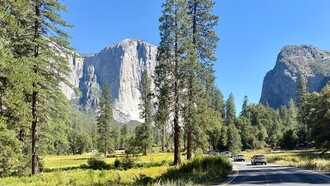Before heading to the beaches of southern Thailand, my husband and I spent 36 hours exploring Bangkok and the surrounding areas. During a 12-hour private tour, we saw massive golden Buddhas, ornate temples and gilded palaces. But the most memorable experiences were at two unique markets, one featured in travel magazines and the other found in unbelievable YouTube videos.
Maeklong Railway Market
Following a 7 a.m. departure and 80-minute ride, our driver parked on a rocky path near a line of single-level, metal-roofed concrete structures. We rounded the corner and could see the train tracks bordered tightly on both sides by nondescript buildings.
Our guide paused to explain that the market had been there long before the railway, and was never relocated. I hesitantly stepped onto the tracks, attempting to ignore my fear (growing up, I’d been told to stay away because trains were dangerous).
My pounding heart slowed as our guide greeted locals who casually ate breakfast and waited for customers. We took photos with a kind middle-aged woman who opened bottled water and washed several unusual fruits so we try them.
In the market center, we ducked under awnings stretched above the tracks. The air was laced with the pungent smells of raw meat and seafood, fragrant fresh flowers, sweet tropical fruits and freshly ground spices. Merchandise was on the ground, on tables, bins and clotheslines. Crushed ice slowly melted under twitching live crabs. A man threaded delicate flowers to add to his growing stack of garlands. I stared at unidentifiable produce of all shapes, colors and sizes, and eyed a bucket of forming soda-flavored ice pops that would be sold by afternoon.
More people arrived hoping to glimpse the scheduled train. Soon, high-pitched whistles were blown, and officials corralled the throngs of eager tourists. To avoid missing last-minute sales, some vendors waited until they heard the train horn to pull back their awnings and wares. The most efficient left low-lying goods next to the tracks, which were, miraculously, not crushed by the passing train.
The train was not yet to the station, but awnings were reopened and merchandise reappeared. The sellers did not give a second thought about their risky routine — which would happen at least two more times that day — but we had seen what we came for.
Damnoen Saduak Floating Market
This was the part of our tour I anticipated the most. Amazing pictures of the floating markets had drawn me to Thailand. We boarded a wooden canoe bound for the busiest floating market, the Damnoen Saduak. The outboard motor roared as the boat sped through residential waterways, creating a wake almost tall enough to splash us.
Arriving at lunchtime, we knew that Thailand’s most famous market would be congested. In every direction, water taxis shuttled foreigners and docked vendors tried to get their attention with cold drinks and kitschy souvenirs.
Farther into the maze, the canals were quieter. Women wearing bamboo hats paddled onward with piles of mangos, bananas and pineapples. Others in docked boats wore cloths across their faces while cooking seafood on open grills.
I had an agenda at the market: to have authentic mango sticky rice and photograph the canals from above. Once back on land, we posed for pictures at two bridges and walked to our guide’s trusted mango sticky rice supplier. From her shore-side boat, she passed our dessert in a basket attached to a bamboo stick.
After lunch at a nearby restaurant, we opened the container of sliced mango (sweet and soft but not mushy) and colorful rice patties. When it was gone, I craved more; I ordered it several times during our stay in Thailand. All were delicious, but none came close to the vibrant periwinkle, lime green and white sticky rice at the Damnoen Saduak Floating Market.















